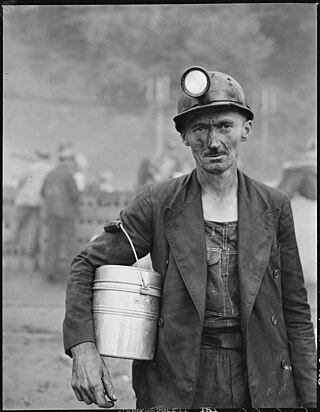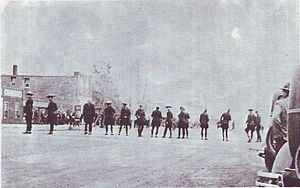
The United Mine Workers of America is a North American labor union best known for representing coal miners. Today, the Union also represents health care workers, truck drivers, manufacturing workers and public employees in the United States and Canada. Although its main focus has always been on workers and their rights, the UMW of today also advocates for better roads, schools, and universal health care. By 2014, coal mining had largely shifted to open pit mines in Wyoming, and there were only 60,000 active coal miners. The UMW was left with 35,000 members, of whom 20,000 were coal miners, chiefly in underground mines in Kentucky and West Virginia. However it was responsible for pensions and medical benefits for 40,000 retired miners, and for 50,000 spouses and dependents.

The On-to-Ottawa Trek was a mass protest movement in Canada in 1935 sparked by unrest among unemployed single men in federal relief camps principally in Western Canada. Federal relief camps were brought in under Prime Minister R. B. Bennett’s government as a result of the Great Depression. The Great Depression crippled the Canadian economy and left one in nine citizens on relief. The relief, however, did not come free; the Bennett government ordered the Department of National Defence to organize work camps where single unemployed men were used to construct roads and other public works at a rate of twenty cents per day. The men in the relief camps were living in poor conditions with very low wages. The men decided to unite and, in 1933, led by Arthur "Slim" Evans, created the Workers' Unity League (WUL). The Workers' Unity League helped the men organize the Relief Camp Workers' Union.

Estevan is the eleventh-largest city in Saskatchewan, Canada. It is approximately 16 km (9.9 mi) north of the Canada–United States border. The Souris River runs by the city. This city is surrounded by the Rural Municipality of Estevan No. 5.
The Asbestos strike of 1949, based in and around the town of Asbestos, Quebec, Canada, was a four-month labour dispute by asbestos miners. It has traditionally been portrayed as a turning point in Quebec history that helped lead to the Quiet Revolution. It also helped launch the careers of Jean Marchand, Gérard Pelletier, and Pierre Trudeau.

The Coal strike of 1902 was a strike by the United Mine Workers of America in the anthracite coalfields of eastern Pennsylvania. Miners struck for higher wages, shorter workdays, and the recognition of their union. The strike threatened to shut down the winter fuel supply to major American cities. At that time, residences were typically heated with anthracite or "hard" coal, which produces higher heat value and less smoke than "soft" or bituminous coal.

The Harlan County War, or Bloody Harlan, was a series of coal industry skirmishes, executions, bombings and strikes that took place in Harlan County, Kentucky, during the 1930s. The incidents involved coal miners and union organizers on one side and coal firms and law enforcement officials on the other. The Harlan County coal miners campaigned and fought to organize their workplaces and better their wages and working conditions. It was a nearly decade-long conflict, lasting from 1931 to 1939. Before its conclusion, an unknown number of miners, deputies and bosses would be killed, state and federal troops would occupy the county more than half a dozen times, two acclaimed folk singers would emerge, union membership would oscillate wildly and workers in the nation's most anti-labor coal county would ultimately be represented by a union.

The Workers' Unity League (WUL) was established in January 1930 as a militant industrial union labour central closely related to the Communist Party of Canada on the instructions of the Communist International.

The Battle of Evarts occurred in Harlan, Kentucky during the Harlan County Wars. The coal miners desired improved working conditions, higher wages, and more housing options for their families. These reasons, along with other factors, led the miners to go on strike. It ended when the Kentucky National Guard was called in to break it up. This battle lasted approximately 15 minutes.

Arthur Herbert "Slim" Evans was a leader in the industrial labor union movement in Canada and the United States. He is most known for leading the On To Ottawa Trek. Evans was involved in the Industrial Workers of the World, the One Big Union, and the Worker's Unity League. He was a member of the Communist Party of Canada.

The Paint Creek–Cabin Creek Strike, or the Paint Creek Mine War, was a confrontation between striking coal miners and coal operators in Kanawha County, West Virginia, centered on the area enclosed by two streams, Paint Creek and Cabin Creek.

Annie Buller, also known as Annie Buller-Guralnick, was a union organizer as well as co-founder of the Communist Party of Canada (CPC) and manager of many CPC publications.
The Westmoreland County coal strike of 1910–1911, or the Westmoreland coal miners' strike, was a strike by coal miners represented by the United Mine Workers of America. The strike is also known as the Slovak Strike because about 70 percent of the miners were Slovak immigrants. It began in Westmoreland County, Pennsylvania, on March 9, 1910, and ended on July 1, 1911. At its height, the strike encompassed 65 mines and 15,000 coal miners. Sixteen people were killed during the strike, nearly all of them striking miners or members of their families. The strike ended in defeat for the union.

Bienfait is a town in Saskatchewan on Highway 18 that is 14 kilometres (8.7 mi) east of Estevan. It is 30 kilometres (19 mi) north-west of the town of North Portal, which is next to the Canada–United States border and is also 10 kilometres (6.2 mi) south of Estevan. It is surrounded by the RM of Coalfields.
The Mine Workers' Union of Canada was a trade union in the mining sector in Canada. MWUC was affiliated to the Workers' Unity League, and lasted for approximately a decade.
The Pana riot, or Pana massacre, was a coal mining labor conflict and also a racial conflict that occurred on April 10, 1899, in Pana, Illinois, and resulted in the deaths of seven people. It was one of many similar labor conflicts in the coal mining regions of Illinois that occurred in 1898 and 1899.

The Illinois coal wars, also known as the Illinois mine wars and several other names, were a series of labor disputes between 1898 and 1900 in central and southern Illinois.

People have worked as coal miners for centuries, but they became increasingly important during the Industrial revolution when coal was burnt on a large scale to fuel stationary and locomotive engines and heat buildings. Owing to coal's strategic role as a primary fuel, coal miners have figured strongly in labor and political movements since that time.

The 1942 Betteshanger Miners' Strike took place in January 1942 at the Betteshanger colliery in Kent, England. The strike had its origins in a switch to a new coalface, No. 2. This face was much narrower and harder to work than the previous face and outputs were reduced. The miners proved unable to meet management production quotas and the mine owners refused to pay the previously agreed minimum daily wage, alleging deliberate slow working. An arbitrator called in to review the dispute ruled that the quotas were achievable. The miners disagreed and went on strike from 9 January.

The Canadian Labour Revolt was a loosely connected series of strikes, riots, and labour conflicts that took place across Canada between 1918 and 1925, largely organized by the One Big Union (OBU).
The Vancouver Island Coal Miners' Strike was from 1912-1914. The coal miners in the Vancouver Islands refused to go to work, in protest of unsafe working conditions and unfair treatment. They began as peaceful protests, until built up anger caused by strike-breakers, also known as scabs, ruined the effectiveness of the strike and incited aggressive behavior. The militia was forced to step in and shut down the strike.
















